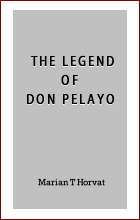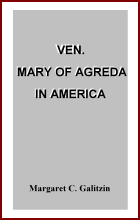Ambiences and Tendencies
 |
 |
 |
 |
 |
 |
 |
Noble Miscegenation:
An Authentic ‘Inculturation’
Let me propose that you take a good look at the painting below and take note of your impressions.
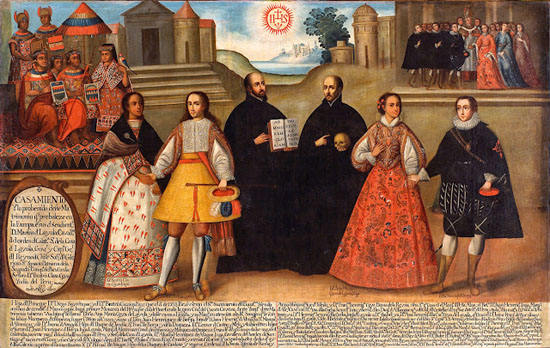
I confess that the first time I saw this painting, I made a superficial and prejudiced analysis. The picture seemed confusing to me.
Many personages, a somewhat archaic Spanish text in calligraphy, multi-colored garments of the lay persons contrasting with the black cassocks of the two priests. In short, it did not make much sense to me.
However, it was painted with great care and everything was done for a reason.
The object of the painting is not just to please the eye. Its ultimate purpose is to present Catholic imperial symbols for its audience – the Indians and Spanish of Peru in the 17th century. With a little research I was able to discover the key that opened the door to its meaning.
* * *
Let me analyze this picture from the point of view of the observer.
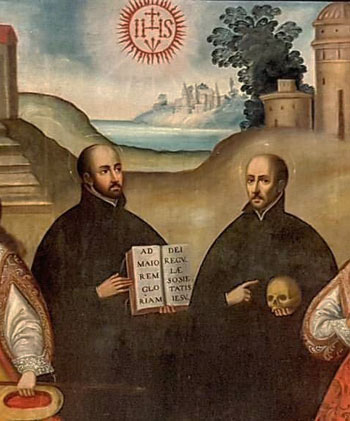 In the upper central point is the symbol (today it would be called the logo) of the Society of Jesus: a sun that represents Our Lord. Incidentally, the sun was also a divine symbol of the Inca Empire.
In the upper central point is the symbol (today it would be called the logo) of the Society of Jesus: a sun that represents Our Lord. Incidentally, the sun was also a divine symbol of the Inca Empire.
Under it we find two preists dressed in black who, although placed in the background of the painting, appear to be the inspirers of the actions taking place in the foreground.
The priest at the left is St. Ignatius of Loyola bearing the Constitution of the Society of Jesus, the Order he founded.
The one at the right is another Jesuit, St. Francis of Borgia, who had been the Duke of Gandia and Viceroy of Catalonia. He points to a skull, a symbol of his renouncement he made of the titles and things of this earth in order to contemplate and fight for the things of eternity.
The two Jesuit Saints are not pictured by chance. There is reason for their presence, as they inspired the policies that led to the marriages in this picture. They also were close relatives of grooms.
The two marriages
Continuing with the analysis, we see that the two couples in the foreground are the protagonists of the scene.
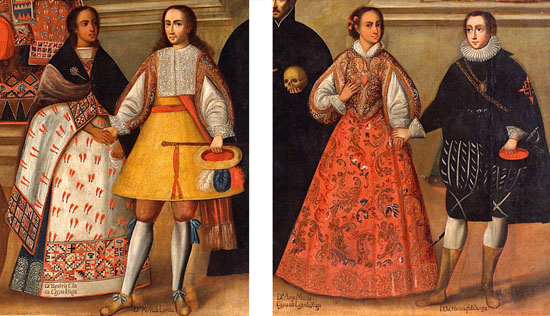
To the left are Martín of Loyola in a yellow suit, a noble knight belonging to the House of Loyola and the great-nephew of St. Ignatius of Loyola, and his spouse, Beatrice Clara Coya, the daughter of the Inca ruler Sayri Tupac (1535-1561).
To the right are Juan of Borgia in black, a Knight of Santiago, a close relative of St. Francis of Borgia, with his wife Ana María Lorenza Garcia Sayri Túpac of Borgia, the noble Hipanic-Inca mestiza, Señora of Yucay Valley and also first Marchioness of Santiago of Oropesa. She was the daughter of the couple at left, so she is also related to the Loyola House through her father.
Both Princesses are descendents of the Inca royal line.
This is a timeless painting, that is, placed outside of chronological time, since both marriages are being blessed at the same moment, even though they took place on different dates and represent different generations.
The first wedding, of Beatrice and Martin, took place in Cuzco, the Inca capital in 1572, and the second wedding is that of their daughter Lorenza, who married Juan in 1611 in Spain. It could well be said that this painting is the "birth certificate" of Peru.
Miscegenation in Peru began with very high social – and religious – notes, promoted by the Crown, welcomed with warm approval by its subjects – both the natives of Peru and the Spaniards – and blessed by the Church. What more could one ask for?
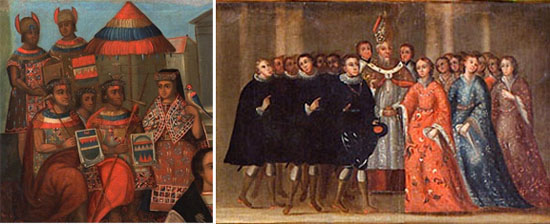
With this, we can identify the personages in the background at left: They are the Inca ancestors of the Princesses, placed according to the criterion of hierarchy and protocol and given the place of highest honor.
At right, on the opposite extreme, we see the nobles, ancestors and relatives of the knights Martín of Loyola and Juan of Borgia.
In the center of that group is a Bishop among the noble caballeros in the black court suits of that time and the grand damas with their fine colored dresses. I could not identify who this Bishop was.
There is a detail that is worth highlighting regarding the many symbols and meanings this painting presents: It is the placement of the hands of the two sets of bride and groom.

Both couples are holding hands. However Martin and Beatrice join their right hands, a symbol of equality of rank, showing that the Crown of Spain gave the same consideration to her Indian subjects as to her Spanish subjects. At that time it was important to make this point about how the Crown considered its subjects in America and Spain very clear.
With the other couple, Juan places his right hand over Lorenza's left hand. What is being emphasized here, I believe, is the role that each spouse plays in the marriage following Church teaching: The wife is subject to the husband.
Here we have a beautiful and noble example of a counter-revolutionary “inculturation,” exactly the opposite of the class-struggle that Progressivism and Communism want to establish in society, setting one class against the other. We see that the nobles of Spain – related to Saints – did not consider it below their status to marry the Inca Princesses of Peru, thus harmonically uniting, by the blessing of the Church and the true Faith, two cultures and peoples.
At the moment someone reads this article, the future of Peru most likely will be sealed for better or for worse, since it is in the process of electing a new president. I ask for the reader's prayers for that noble Nation.
St. Rose of Lima, Patroness of the Americas and the Philippines, pray for us.


I confess that the first time I saw this painting, I made a superficial and prejudiced analysis. The picture seemed confusing to me.
Many personages, a somewhat archaic Spanish text in calligraphy, multi-colored garments of the lay persons contrasting with the black cassocks of the two priests. In short, it did not make much sense to me.
However, it was painted with great care and everything was done for a reason.
The object of the painting is not just to please the eye. Its ultimate purpose is to present Catholic imperial symbols for its audience – the Indians and Spanish of Peru in the 17th century. With a little research I was able to discover the key that opened the door to its meaning.
* * *
Let me analyze this picture from the point of view of the observer.

Under it we find two preists dressed in black who, although placed in the background of the painting, appear to be the inspirers of the actions taking place in the foreground.
The priest at the left is St. Ignatius of Loyola bearing the Constitution of the Society of Jesus, the Order he founded.
The one at the right is another Jesuit, St. Francis of Borgia, who had been the Duke of Gandia and Viceroy of Catalonia. He points to a skull, a symbol of his renouncement he made of the titles and things of this earth in order to contemplate and fight for the things of eternity.
The two Jesuit Saints are not pictured by chance. There is reason for their presence, as they inspired the policies that led to the marriages in this picture. They also were close relatives of grooms.
The two marriages
Continuing with the analysis, we see that the two couples in the foreground are the protagonists of the scene.

To the left are Martín of Loyola in a yellow suit, a noble knight belonging to the House of Loyola and the great-nephew of St. Ignatius of Loyola, and his spouse, Beatrice Clara Coya, the daughter of the Inca ruler Sayri Tupac (1535-1561).
To the right are Juan of Borgia in black, a Knight of Santiago, a close relative of St. Francis of Borgia, with his wife Ana María Lorenza Garcia Sayri Túpac of Borgia, the noble Hipanic-Inca mestiza, Señora of Yucay Valley and also first Marchioness of Santiago of Oropesa. She was the daughter of the couple at left, so she is also related to the Loyola House through her father.
Both Princesses are descendents of the Inca royal line.
This is a timeless painting, that is, placed outside of chronological time, since both marriages are being blessed at the same moment, even though they took place on different dates and represent different generations.
The first wedding, of Beatrice and Martin, took place in Cuzco, the Inca capital in 1572, and the second wedding is that of their daughter Lorenza, who married Juan in 1611 in Spain. It could well be said that this painting is the "birth certificate" of Peru.
Miscegenation in Peru began with very high social – and religious – notes, promoted by the Crown, welcomed with warm approval by its subjects – both the natives of Peru and the Spaniards – and blessed by the Church. What more could one ask for?

At left, the Inca nobility in their traditional gala dress; at right, the Spanish nobility
With this, we can identify the personages in the background at left: They are the Inca ancestors of the Princesses, placed according to the criterion of hierarchy and protocol and given the place of highest honor.
At right, on the opposite extreme, we see the nobles, ancestors and relatives of the knights Martín of Loyola and Juan of Borgia.
In the center of that group is a Bishop among the noble caballeros in the black court suits of that time and the grand damas with their fine colored dresses. I could not identify who this Bishop was.
There is a detail that is worth highlighting regarding the many symbols and meanings this painting presents: It is the placement of the hands of the two sets of bride and groom.

At left, Martin & Beatrice; at right, Juan & Lorenza
Both couples are holding hands. However Martin and Beatrice join their right hands, a symbol of equality of rank, showing that the Crown of Spain gave the same consideration to her Indian subjects as to her Spanish subjects. At that time it was important to make this point about how the Crown considered its subjects in America and Spain very clear.
With the other couple, Juan places his right hand over Lorenza's left hand. What is being emphasized here, I believe, is the role that each spouse plays in the marriage following Church teaching: The wife is subject to the husband.
Here we have a beautiful and noble example of a counter-revolutionary “inculturation,” exactly the opposite of the class-struggle that Progressivism and Communism want to establish in society, setting one class against the other. We see that the nobles of Spain – related to Saints – did not consider it below their status to marry the Inca Princesses of Peru, thus harmonically uniting, by the blessing of the Church and the true Faith, two cultures and peoples.
At the moment someone reads this article, the future of Peru most likely will be sealed for better or for worse, since it is in the process of electing a new president. I ask for the reader's prayers for that noble Nation.
St. Rose of Lima, Patroness of the Americas and the Philippines, pray for us.

Posted on June 23, 2021
______________________
______________________



